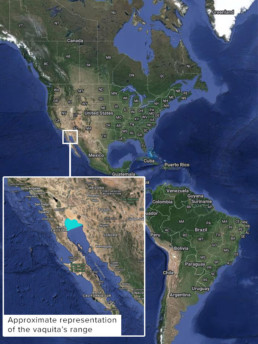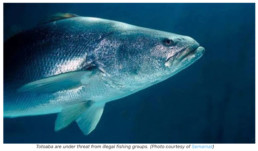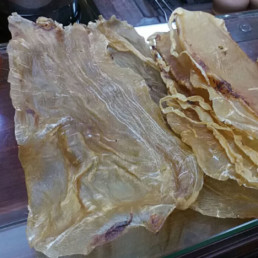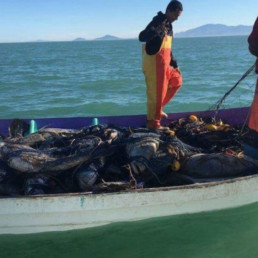Goal
Our goal is to save the Vaquita porpoise from extinction. The Vaquita is the most endangered marine mammal on Earth. As of 2024 only six to eight individuals are suspected to exist. Although vaquitas once numbered thousands, since 2014 the number of suspected individuals has hung on at approximately 10. Today the remaining vaquitas are found primarily in the designated Vaquita Refuge.

Field Partner
ICF collaborates with two field partners to save the vaquita porpoise from extinction.
The Cetacean Action Treasury collaborates with Mexican organizations to facilitate the adoption of fishing gear that doesn’t endanger vaquitas and to locate and remove illegal nets from the Vaquita Refuge. Additionally, they provide backing for research on the status of vaquitas, a crucial endeavor aimed at persuading authorities of the species’ continued viability.
Pronatura Noroeste is Mexico’s oldest conservation organization. The organization’s approach revolves around collaborative management with local communities, governmental bodies, non-profit organizations, and research institutions. Together, they strive to preserve the ecological wealth of their ecosystems while safeguarding the biodiversity, flora, fauna, and fisheries resources within them.
Size of Area Involved
The vaquita (Phocoena sinus) is the most endangered marine mammal species in the world. It has a very restricted distribution, occurring only in the upper Gulf of California in Mexico. The present range of the vaquita is limited to approximately 4,000 km2, with the highest-use area about 2235 km2, however, the few remaining vaquitas now appear to be concentrated in a small area near San Felipe about 24 x 12 Km in size.
Location

The Vaquita Refuge in the northwest sector of the Upper Gulf of California, near San Felipe, Baja, Mexico
Maps data © 2024 Google
Rare footage of a vaquita and her calf
Totoaba Trade: A Menace to Vaquita Survival
The vaquita porpoise (Phocoena sinus, CR) is the most endangered marine mammal on Earth with as few as 6 to 8 as of May 2024. The rapid decline of its population from thousands to fewer than 20 is due to illegal gill-netting of the Totoaba (Totoaba macdonaldi), a similar-sized (1-meter) fish. The swim bladder of the totoaba fetches tens of thousands of dollars in China. Illegal gill-netting in the vaquita reserve’s No Take Zone is also depleting others marine sea life, including the totoaba (VU).

The decline of this diminutive porpoise is entirely due to illegal gill netting. The illegal fishing centers around the harvest of swim bladders from totoaba fish, which are exported to China where prices approach US$5,000 per swim bladder.

Dried swim bladders of totoaba fish, which despite an international ban on trade are still available at a traditional medicine shop in Guangzhou, China on March 1, 2018. Photo: Joanna Chiu/AFP via Getty Images.
Fishermen with an illegal haul of totoaba. Photo courtesy of Elephant Action League.

Community-Based Certification: Monitoring Fishing Practices
Since 2022 ICFC and ICF have provided funds for two complementary projects for the vaquita. With the Cetacean Action Treasury, we are funding the efforts of local Sea Scouts who patrol the boundaries of the Zero Tolerance Area (ZTA) within the Vaquita Refuge meant restrict to gill-netters from entering by warning that there are 200 submerged anti-net devices in the area. The Sea Scouts also assist with removing submerged nets that were snagged by the devices (“ghost nets”).

Support provided to Pronatura Noroeste supports local fishers to switch to “vaquita friendly” fishing gear such and seafood products harvested in this manner are branded as legally obtained and fetch higher prices. The project works with a local women’s organization (MAREM) to implement a community-based certification program to monitor and promote fishermen who comply to fishing regulations using alternative fishing gear. In parallel, a fisheries improvement project with the Marine Stewardship Council has been launched to guide local fisheries toward sustainability with additional economic incentives such as fuel compensation to fish in areas beyond the Zero Tolerance Area.

There is a risk of failure, but also a real chance of success. A genetic analysis indicated that the population could recover and thrive if illegal fishing mortality is curbed. And many other species have been brought back from the brink. We believe we must make this final effort.

